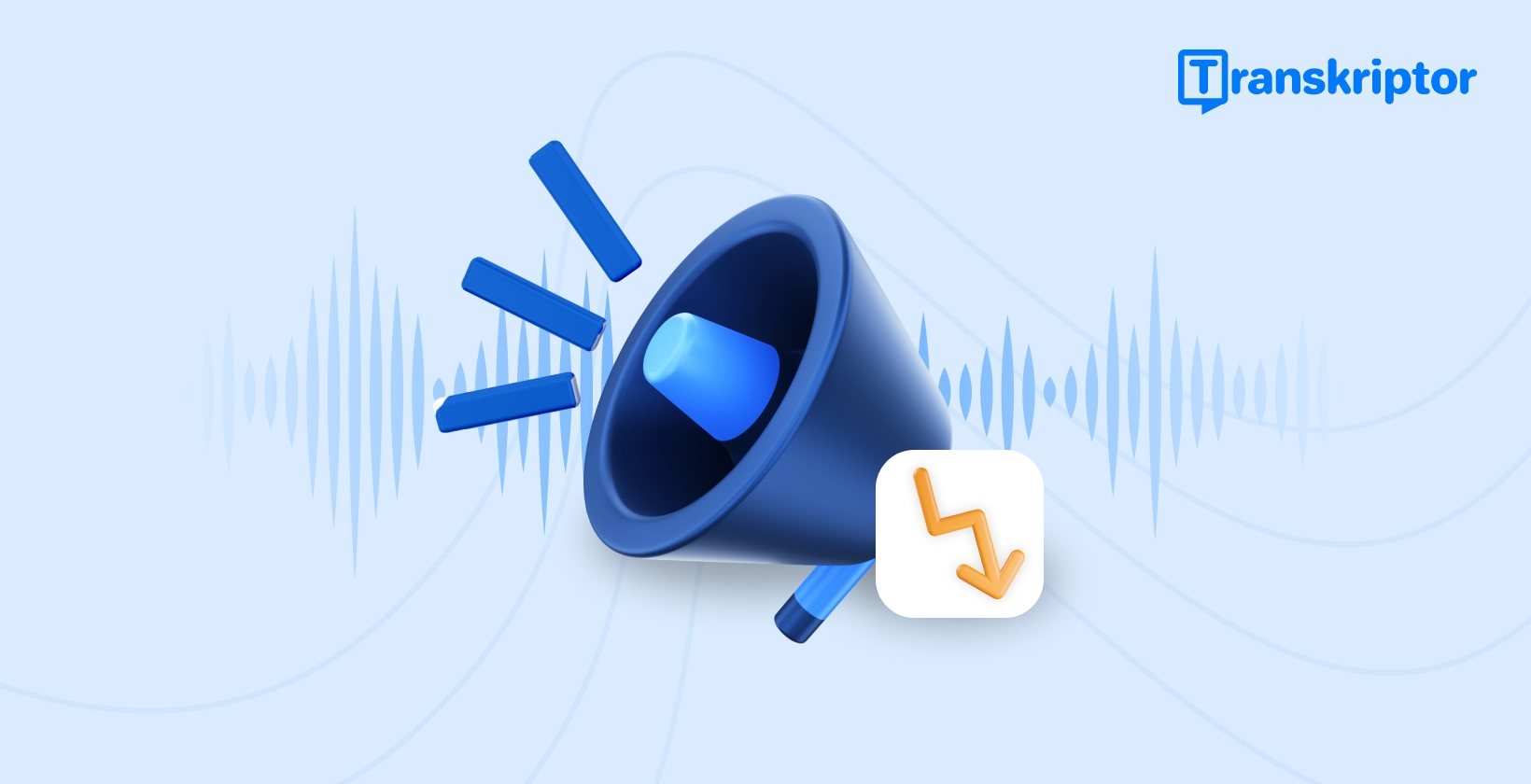Background noise compromises speech-to-text accuracy because it obscures what the person is saying and prevents you from being able to hear them properly, so it’s difficult for human transcriptionists (and automatic transcription software) to decipher their speech.
Ultimately, background noise distracts listeners from the focus of the audio (your voice) and gives rise to interruptions that detract from the purpose of the recording.
Prevention is key when it comes to reducing background noise, so improve the acoustics of the room you record in as much as possible by sealing all gaps to the outside with materials you have on hand and filling them with soft materials that absorb sound (like curtains and upholstered furniture). Additionally, make sure to avoid scheduling recording sessions at high-traffic times and install background noise removal software ahead of time to process the audio afterward.
Alternatively, save yourself time by opting for a transcription tool like Transkriptor with built-in background noise removal and a state-of-the-art speech recognition engine that delivers near-perfect accuracy (even in loud environments), including the use of audio transcription software .
What Causes Background Noise in Audio Recordings?
Background noise arises from a variety of sources, and ranges from barely noticeable (like electronic hum) to impossible to ignore (like the siren of an emergency vehicle). Moreover, unless you have a dedicated space for recording audio, it’s hard to avoid other people (and animals) interrupting your session and creating background noise.
Common Sources of Background Noise
Background noises are sounds that you don’t want to be heard in an audio recording because they draw attention away from the main focus, so you take precautions to minimize them. There is a spectrum of background noise, ranging from barely noticeable to disruptive, which arises from a variety of sources.
Electronics like televisions and air conditioning systems produce a constant hum, so they are common sources of low-level background noise, but other sources like traffic outside and weather (like rain, wind, or thunder) are more extreme. Another common source of background noise is other people, and often animals, who enter the space where you are recording and make sound in close enough proximity to the microphone that is it picked up in the recording.
Avoiding background noise – whether that is electronic hum, traffic outside, weather, other people, or animals – is difficult when you don’t have a dedicated space for recording audio.
Impact of Background Noise on Audio Quality and Transcription Accuracy
Background noises interfere with the quality of audio recordings because they obscure speech, making it harder to hear what the person is saying, and complicate the ‘cleanup’ process (of removing unwanted sounds). Given that the background noise is not the focus of the recording, and listeners don’t gain any information from hearing it, minimizing it is crucial for the audio quality.
It is important to note that although people record audio in a variety of settings, from noisy construction sites to silent lecture halls, it is impossible to make an accurate transcript of a recording that has excessive background noise. Background noises make speech less clear, which forces you to spend more time deciphering what is said and less time on the content you are using the transcript to create.
At best, background noise slows the process of transcription down, and at worst, makes it impossible. Automatic transcription software removes background noise, but it’s not perfect, so they struggle with overlapping speech and establishing context for words. Ultimately, the quality of the audio determines the accuracy of the transcription – for manual transcription and automatic transcription.

How to Reduce Background Noise for Clearer Audio?
It’s important to choose your equipment wisely when you record audio, both to make sure that the sound is high quality and to reduce the amount of background noise. Noise-canceling devices, like microphones and headsets, are a wise investment for people who record audio regularly because they automatically cancel out background noise, so you don’t have to record in a silent room or waste time trying to transcribe unclear audio.
Using Noise-Canceling Microphones and Headsets
Noise-canceling technology is a revelation for recording audio because it automatically neutralizes background noise - it analyzes your surroundings and generates the opposite sound waves to cancel any sound out.
Noise-cancelling microphone setups work with a primary microphone next to your mouth which picks up your voice and a secondary microphone facing away from you which captures background noise, so the technology can suppress the latter.
A noise-canceling microphone setup is a wise investment for people who record audio regularly because it minimizes background noise automatically, meaning you don’t have to worry about your environment being completely silent or spending hours trying to transcribe garbled audio.
Noise-canceling headsets are useful for recording audio because they allow you to hear yourself while you are recording, so you can make sure that you are speaking, maintaining a reasonable speed, and enunciating every word. One thing to consider when you are wearing a noise-canceling headset to record audio is ‘spill’, or leakage, which is when sound escapes from the headphones and gets picked up by the microphone (which is unideal because you want the microphone to capture only your voice).
People who record audio regularly - like musical artists, voice actors, and podcast hosts – opt for closed-back noise-canceling headphones (instead of the standard open-back) because they leak less audio.
Adjusting Microphone Settings for Optimal Noise Reduction
The two microphone settings to adjust for optimal noise reduction are: boost and background noise. The microphone boost setting refers to the strength of the signal, so increasing the strength increases the amplification. Simply turn the boost setting down completely on your microphone to make your voice clearer about the background noise.
On the other hand, most microphones have a background noise setting (which also goes by noise reduction and suppression) which you can turn on to minimize the number of sounds from your environment that make it into the recording.

What Are the Best Tools for Background Noise Reduction?
Noise-canceling technology transformed the process of removing background noise from audio, because not only is it able to minimize background noise in real-time as someone speaks into a microphone, but it also automatically filters out unwanted sounds from recordings during post-production.
Cleaning audio up is a time-consuming process and takes newcomers a long time to get the hang of, so noise-canceling software makes it quick, easy, and pain-free to remove background noises from recordings.
Audio Editing Software with Noise Reduction Features
Noise-canceling technology registers the sounds happening in the background and produces an opposite soundwave, canceling them out and making sure your voice is the center of attention. Audio editing software with noise reduction features, or noise-canceling software, allows you to eliminate background noise from live audio (like virtual meetings) as well as recorded audio.
Cleaning up audio recordings by hand, by isolating specific sounds and reducing their volume, is time-consuming and complicated (especially for novices who have to learn how to use audio editing software). So, audio editing software with noise reduction features simplifies the process of removing background noise from audio by doing it automatically – both for steady background noises like humming and sudden interruptions like coughs or ringing cell phones.

Voice Recognition Software with Built-In Noise Cancellation
Built-in noise cancellation is a feature that makes voice recording apps stand out from the other options on the market. People who don’t record audio regularly are reluctant to spend money on expensive equipment with built-in noise cancellation or dedicate tens of hours to learning how to use audio editing software to remove background noise by hand, so voice recognition software with built-in noise cancellation is a great option because it allows you to use a device you already own.
Voice recognition software with built-in noise cancellation makes it quick, easy, and simple to minimize background noise when you record audio.
How Does Transcription Software Help with Noise Reduction?
Transkriptor is a transcription software that leverages artificial intelligence to remove background noise, deliver the complete transcript in less than half the duration of the original recording, and separate overlapping speech. Transkriptor is affordable, easy to use, and allows novices to achieve the same results as seasoned experts – using a device they already own to record audio.
Background noise removal is a major perk of transcription software because it makes sure that the focus in your voice, rather than other sounds happening in the room where you record, without expensive equipment or editing in post-production.
Benefits of Using Transcription Services Like Transkriptor
Transkriptor is an automatic transcription tool that leverages artificial intelligence to remove background noise – so you don’t have to worry about the environment you record in being completely silent, nor be concerned that unexpected interruptions are going to compromise the recording.
The speech recognition engine that Transkriptor uses delivers 99% accurate transcripts in less than 2 minutes, even when the audio contains several background noises and people speaking over each other.
The best place to record audio is in a private and soundproofed room, with specialized equipment designed to deliver high-resolution sound. However, a dedicated recording setup isn’t accessible for most people – like hobbyists, students, and professionals whose industry is unrelated to audio.
Transkriptor is a tool for everyone because it allows newcomers to achieve the same results as seasoned experts without having to buy a new device, invest in expensive automatic transcription software, or dedicate several hours to learning everything there is to know about audio recording. Transkriptor offers users 99% accurate transcripts, automatic background noise removal, and support for over 100 languages – packaged with an an easy-to-use interface.
How Noise Reduction Enhances Transcription Accuracy in Noisy Environments
Noise reduction enhances transcription accuracy in noise environments because it filters out unwanted sounds, by generating an opposite soundwave which cancels them out, and allows your voice to be the focus of the recording without having to use specialized equipment or ‘clean’ the audio in post-production.
Noise reduction makes sure that the speech in audio recording is clear, so the human transcriptionist or automatic transcription software can comprehend what is being said and create a transcript that reflects the recording.

What Techniques Can Improve Speech Clarity in Noisy Settings?
Beyond making sure that you record audio in a quiet environment, you also need to place the microphone a suitable distance from your mouth, consider the acoustics of the room you record in, and avoid recording at a high-traffic time of day. Moreover, soundproofing the room you record in helps a great deal to prevent noise from entering.
Tips for Reducing Ambient Sound During Recordings
Ambient sound is annoying but inevitable. Given that soundproofed studios are inaccessible for many people who record audio, the best things to do to reduce ambient sound during recording are:
- Place the microphone 15 to 20 centimeters from your mouth. The sweet spot for the distance between your mouth and the microphone is between 15 and 30 centimeters, to make sure that it picks up everything you say without compromising the quality of the sound.
- Use background noise removal software. Background noise removal software, or noise-canceling software, identifies your voice in audio recordings and filters out the other sounds that aren’t your speech.
- Record in a room with good acoustics. The acoustics of a room determine how sound waves bounce around space. Rooms with a lot of carpet, upholstered furniture, and curtains are better for recording audio because they absorb sound, enabling the microphone to pick up your voice.
- Record at a low-traffic time of day. Rush hour (in the morning or evening) is a bad time to record audio because lots of people are walking around and driving their cars, causing a commotion outside of the building which the microphone picks up.
- Rent a soundproofed location. Rent a rehearsal room or recording studio equipped with professional-grade soundproofing to record in, to avoid ambient noise. Some cities even have dedicated podcast studios for rent, which you can book (including the equipment it contains) to record high-quality audio.
Using Soundproofing and Acoustic Treatments
Despite common misconceptions, soundproofing and acoustic treatment are vastly different approaches to improving the acoustics of a room. The focus of soundproofing is preventing sound entering a room, by sealing gaps around doors or windows and adding layers of soundproofing materials.
On the other hand, the focus of acoustic treatment is improving the way that sound travels around a room - by furnishing it with soft materials that absorb or diffuse sound waves instead of deflecting them.
How to Optimize Audio for Better Speech-to-Text Conversion?
Speech-to-text conversion relies on what the person is saying in the recording to be as clear as possible, so you must do your best to soundproof the room by closing all doors, shutting all windows, and plugging any gaps with the materials that you have on hand.
With regards to post-production, use background noise removal software or automatic transcription software with built-in background noise removal to optimize the audio for speech file to text .
Preparing Your Environment for Optimal Audio Recording
Preparing your environment before you start to record audio is essential, as you want to avoid having to stop halfway through the session to adjust the room. Close all doors and windows to prevent noise from entering the room, plugging any gaps with supplies you have on hand (from an old blanket to specialized soundproofing material). Moreover, furnish the room you record in with as much fabric as possible – curtains, upholstered furniture, blankets – to diffuse any sounds that are not your voice.
Best Practices for Achieving High Speech-to-Text Accuracy with Background Noise
Transcription software struggles to process background noise because it obscures speech, making it harder for the technology to identify what the person is saying. As such, the best thing to do to achieve high speech-to-text accuracy for audio addled with background noise is to pass it through background noise removal software before uploading it to the transcription software.
The background noise removal software identifies the background noise, any sounds which are not your voice, and automatically removes them from the recording. Alternatively, make sure to use transcription software that has background noise removal built in – like Transcriptor - to avoid using two separate apps for one task.
Conclusion
It’s crucial to reduce background noise when you record audio, both to ensure that the voice of the person speaking is the focus of the recording and to allow speech-to-text software to work.
Using the right equipment, like a noise-canceling microphone and transcription software with built-in noise reduction like Transkriptor, reduces background noise, enhances the clarity of audio recordings, and enables speech-to-text software to generate accurate transcripts.






